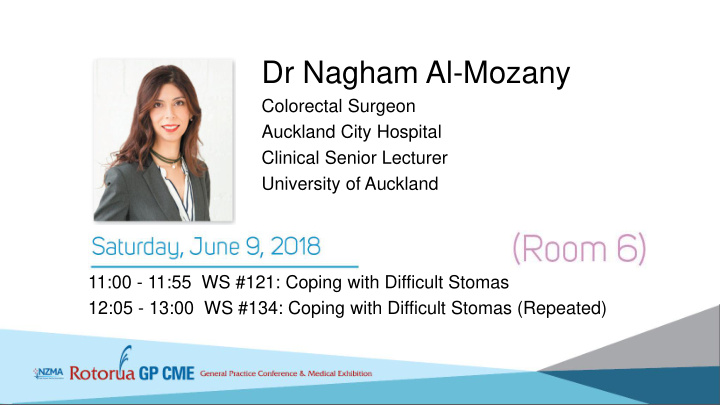



Dr Nagham Al-Mozany Colorectal Surgeon Auckland City Hospital Clinical Senior Lecturer University of Auckland 11:00 - 11:55 WS #121: Coping with Difficult Stomas 12:05 - 13:00 WS #134: Coping with Difficult Stomas (Repeated)
COPING WITH DIFFICULT STOMAS- BRIDGING THE GAP DR. NAGHAM AL-MOZANY CONSULTANT GENERAL & COLORECTAL SURGEON AUCKLAND CITY HOSPITAL & MACMURRAY CENTRE
BRIDGING THE GAP Knowledge Doctor-patient relationship Patients with stoma & Family/Society
OBJECTIVES • Definition and types of stomas • Indications for stoma formation • How to recognize the type of stoma? • Recognizing the complications? • How to manage simple complications ? • When to refer ? • Support services available?
DEFINITION
INTESTINAL STOMA
CLASSIFICATION OF STOMAS Stoma Temporary vs. Permanent Source Type Technical type
ILEOSTOMY
Ileostomy consistency: TOOTH-PASTE!
Loop/Defunctionning Ileostomy
HOW CAN I TELL THE DIFFERENCE?
WHO CARES? • Effect on reversibility of the stoma in future? • Volume of output? • Effect on complications?
WHO CARES? Effect on reversibility of the stoma in future? Potentially Yes if End ……and YES if Loop Volume of output? 1 L Effect on complications? -High output >1L -Dehydration/Electrolyte imbalance -Skin issues -Leaking bag
COMPARISON BETWEEN STOMAS Table 1.
ILEAL CONDUITS URINARY DIVERSION • Form of Urostomy • Diverts urine if bladder has been removed • Common problem is urine infection • Issues: Refer to Urology
A SURGEON’S PERSPECTIVE
Indications for surgery/stoma formation
TECHNICAL ASPECTS OF STOMA FORMATION
POST-OPERATIVE COMPLICATIONS
INDICATIONS FOR STOMA TYPE
INDICATIONS FOR ILEOSTOMY FORMATION Emergencies: • Conditions that require small bowel or colon resection and a primary anastomosis (“join”) which may be compromised • Friable unhealthy bowel tissue unable to hold a suture: • Long-standing peritonitis or obstruction • Radiation • Crohn’s disease • Perforation • Trauma • Severe infection
INDICATIONS FOR ILEOSTOMY FORMATION Elective: • Surgery for rectal cancer or inflammatory bowel disease • Technically easier to reverse
INDICATIONS FOR COLOSTOMY FORMATION Emergencies: • Colonic obstruction from a cancer • Complicated diverticular disease • Trauma Elective: • Very low rectal cancers • Fistula • Severe incontinence • Radiotherapy • Severe perianal sepsis
• Counselling • Stoma nurse specialists
• Stoma management STOMA training EDUCATION • ↓Time to ostomy proficiency • ↓ Length of hospital stay • ↓ Unplanned interventions • Highly cost effective
STOMA SITING Lying Standing Sitting
STOMA COMPLICATIONS
High Stoma output ?
HIGH STOMA OUTPUT Risk factors:
HIGH STOMA OUTPUT Dehydration • 30% of patients with new ileostomies • Fluid and electrolyte replacement strategies • Vitamin deficiencies and malnutrition • Avoid kidney failure • Dehydration and kidney failure are also the most common cause of unplanned readmission in stoma patients
SO WHAT CAN YOU DO? • Enquire about stoma losses • Number of bag changes and volume in bag • Aim for 1L stoma loss for ileostomies • Regular Creatinine, UE checks, Albumin, Vitamins • Enquire about skin around stoma bag
PARASTOMAL HERNIA • Risk factors: Poor tissues / weak musculature • Oversized apertures • Wound infections • Obesity • Smoking • Advanced age • Increased abdominal pressure after surgery
SO WHAT CAN YOU DO? • Refer to stoma specialist for pouch/belt support • Refer to colorectal surgeon if symptomatic, for consideration of revision, re-siting, repair of hernia • Check integrity of stoma- not ischaemic or necrotic • Analgesia
MANAGEMENT OF PARASTOMAL HERNIA
• Operative repair / re-siting strategies • +/- Mesh use • Laparoscopic or Open surgery
STOMAL BLEEDING • Poor pouching technique • Stoma rubs against an appliance resulting in trauma • More prevalent in patients with parastomal hernias and prolapse • Management includes patient education and pouch resizing to eliminate the causative factors • Refer to stoma nurse specialist
MUCOCUTANEOUS SEPARATION Risk factors include: 1. Surgical wound infections 2. Oversized skin holes 3. Excessive suture tension 4. Stomal necrosis • Superficial separations can be managed by stomal therapists, who will fill the separation with an absorbant product to facilitate healing • Deep separations below the level of the abdominal fascia may warrant surgical revision
NECROSIS • Occur within 1-5 days of surgery • Particularly the first 24 hours • Risk factors: 1. Oedema 2. Abdominal distension 3. Critical illness 4. Obesity 5. Tension
SO WHAT CAN YOU DO? • Clinical assessment is important • Check tightness of the stoma appliance • Inserting a test tube into the stoma may aid in depth assessment • Refer acutely to Colorectal surgeon
STOMAL PROLAPSE Risk factors: 1. Large abdominal wall opening 2. ↑ Abdominal pressure 3. Lack of fascial support 4. Obesity 5. Weak muscle tone and certain anatomical locations • Painless • ↑ risk of stomal trauma • ↑ risk of incarceration and ischaemia
STOMAL PROLAPSE
Patient is lying down and stoma is on the patient’s right
Refer to stoma nurse specialist
Refer to Surgeon
STOMAL RETRACTION Risk factors: 1.Necrosis 2.Mucocutaneous separation 3. Crohn’s disease 4.Excessive tension Expert stomal therapist input is required/Refer
STOMAL STENOSIS Result from: 1.Mucocutaneous separation 2.Ischaemia or necrosis 3.Following chronic skin irritation 4.Excessive scarring 5.Irradiation Management: Refer! 1.Dilation with gloved fingers +/- graded surgical dilating instruments 2.Stool softeners may assist in avoiding impaction
A PATIENT’S PERSPECTIVE
How do we bridge the gap between patients with stomas & family/society
FAMILY AND SOCIETY
A PATIENT’S AND SOCIETY’S PERSPECTIVE • Malodorous • Noisy • Unable to eat normal food • Unable to exercise • Unable to wear normal clothes • Unable to bath, shower, or swim • Unable to work • Unable to travel • Unable to have sex • Loss of partner and friends
“THE STOMA EFFECT”
Recommend
More recommend